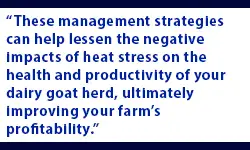
Managing heat stress in dairy goats
 By Dr. David Carlson
By Dr. David Carlson
Heat stress is a costly condition for many species of livestock, causing suboptimal health and productivity. This is certainly true for goats as their thermoneutral zone – the environmental temperature at which the animal can maintain body temperature with little to no effort – is estimated to be between 50 and 68 degrees F. In North America, dairy goats spend quite a bit of time in weather conditions outside of that zone.
Dairy goats experiencing heat stress will compensate in several ways to maintain body temperature, both by accelerating heat loss and decreasing heat production. Dairy goats cope with heat stress through:
- Decreased activity
- Lower feed intake
- Increased respiration rate
- Sweating
- Lower productivity (growth, milk yield)
- Compromised immune function
 Critical management strategies to help animals cope with heat stress include:
Critical management strategies to help animals cope with heat stress include:
- Shade: Goats should be provided with shade to help reduce heat gain from direct sunlight.
- Bedding: Heat-stressed goats may urinate more due to greater water intake, so bedding may get soiled more quickly. Increased disease risk due to depressed immune function is also a good reason to focus on clean and dry bedding.
- Space: Ensure adequate space (18 to 20 square feet per doe) to allow for behavioral adaptations to heat stress, such as seeking shade and increased standing time.
- Water: Goats will increase water intake to help replenish fluids lost in sweat and by panting. Ensure access to clean water at multiple places throughout the facility.
- Electrolytes: Heat stress will cause more electrolyte loss through sweat, urine and saliva. Offering a palatable electrolyte solution may improve electrolyte balance.
- Fans: Providing adequate air speed with fans can help dairy goats dissipate heat from their bodies through evaporative cooling. Fans may be used in the housing facility, holding pen and parlor.
- Feeding frequency: Consider increasing the frequency of hay feeding to promote feed intake, focusing on fresh feed availability in the cooler parts of the day.
- Fly control: Excessive fly pressure can exacerbate the impacts of heat stress by causing animals to bunch in response to biting flies. Consider fly control strategies that target both adult flies and larvae – these can include pesticides as well as increased focus on areas where fly larvae develop (e.g., manure, decaying organic matter, tall grass).
These management strategies can help lessen the negative impacts of heat stress on the health and productivity of your dairy goat herd, ultimately improving your farm’s profitability.
About the author: Dr. David Carlson is a Vita Plus dairy nutritionist and technical services specialist. He was raised on a small dairy farm in North Dakota and attended North Dakota State University (NDSU) to earn a bachelor’s degree in animal sciences and a master’s degree in ruminant nutrition. He received his Ph.D. in dairy nutrition from the University of Illinois at Urbana-Champaign, where his research focused on transition dairy cow nutrition. He was postdoctoral research fellow at NDSU before working with a milk replacer manufacturer and an animal health company. At Vita Plus, Carlson provides technical support for field staff, dealers, and customers in southern Wisconsin, northern Illinois, and eastern Iowa. He also leads Vita Plus dairy nutrition and management training initiatives.
| Category: |
Animal health Dairy Goat Performance |

